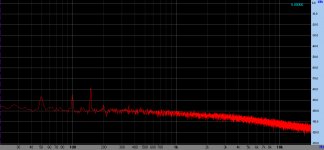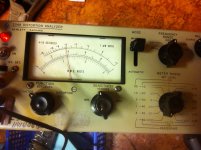Lower (300B heater, measuring on 10R).The Coleman regulator gives microampere-level ripple, or even lower...
Attachments
Last edited:
Dear Scutterflux
Inductor will help sound in the HT supply.
Coleman regulator is only the filament supply of the DHT.
It mainly keeps out the 50hz hum and other high frequency hash from
DHT SE sound. As a bonus we get soft start and regulated filament current in the
fragile DHT filaments found in current production tubes which is a must for long life of the tube.
Inductor will help sound in the HT supply.
Coleman regulator is only the filament supply of the DHT.
It mainly keeps out the 50hz hum and other high frequency hash from
DHT SE sound. As a bonus we get soft start and regulated filament current in the
fragile DHT filaments found in current production tubes which is a must for long life of the tube.
In a DHT even a six inch wire will effect the sound (in my amp at the least), whether it is copper,silver, litz, solid, stranded different gauges, and the different dielectrics. So I'm not sure what you're trying to tell me. Rod's Regulator is great because it minimizes everything north of the chain due to high impedance, I believe it even minimizes most of it's own circuit.
I'm glad everyone is so impressed and regards the Coleman regulators with such esteem that trying anything is just out of the question. (I assume this is why everyone is so discouraging of my proposed subjective test). It really makes me feel confident in my purchase which should be here soon.
Anyway I will be trying with a 60mH hammond inductor after I become intimately familiar with the sound of the regulators.
I'm glad everyone is so impressed and regards the Coleman regulators with such esteem that trying anything is just out of the question. (I assume this is why everyone is so discouraging of my proposed subjective test). It really makes me feel confident in my purchase which should be here soon.
Anyway I will be trying with a 60mH hammond inductor after I become intimately familiar with the sound of the regulators.
since you are so much on to chokes the best improvement i got was by inserting a common mode choke in between the regulator and the filament. any other type of choke would be an antenna for unwanted noise pickup. l wound the choke myself using a one inch ferite ring and two windings of about 25 turns each of heavy guage enamal wire wound in opposite directions on opposite sides.
I can do that, I have couple 1-inch rings lying around, that also might be worth a try for fun. However I'm not really looking to reduce any common mode noise, also I don't think a CMC would do well with my attempt to hear the LCL filament supply sound.
Why do some guys use LCL filament supply and even prefer it if it's just a large antenna?
I just want to make it clear that I have no opinion on which sound or method I prefer I am just looking at options. If I'm going to try a constant current source I'll A/B two methods and pick what I prefer that's all. I just think combining the two and using maybe a 30-60mH choke as opposed to a pure LCL with a 200-400mH choke might give similar if not better results. So my intention is to A/B Coleman regulator to a hybrid L-C-L so to speak, a L-[C-R-C]-[Coleman-L]
Why do some guys use LCL filament supply and even prefer it if it's just a large antenna?
I just want to make it clear that I have no opinion on which sound or method I prefer I am just looking at options. If I'm going to try a constant current source I'll A/B two methods and pick what I prefer that's all. I just think combining the two and using maybe a 30-60mH choke as opposed to a pure LCL with a 200-400mH choke might give similar if not better results. So my intention is to A/B Coleman regulator to a hybrid L-C-L so to speak, a L-[C-R-C]-[Coleman-L]
I remembered Petavgeris posted in the New DHT Heater thread about his experience using chokes in the filament supply. You may find some answers searching for his posts in that thread.
http://www.diyaudio.com/forums/tubes-valves/38248-new-dht-heater-43.html#post2905388
Adrien.
http://www.diyaudio.com/forums/tubes-valves/38248-new-dht-heater-43.html#post2905388
Adrien.
scutterflux
Inductors in the filament supply. You could find very interesting reading
Great article from Vinylsavor on filament bias concept*.
-----yagoolar
VinylSavor: Filament Bias, Part 1: Concept
Inductors in the filament supply. You could find very interesting reading
Great article from Vinylsavor on filament bias concept*.
-----yagoolar
VinylSavor: Filament Bias, Part 1: Concept
1st Question : what is better for filament in long-term usage; supply with inrush current vs CCS(and voltage)?
To my logic is Ccs but one guy said that is not(he have years experience in tube technology vs me little) . I'm confused... And wish correct answer
2nd Question : (that one is more for Mr. Coleman) in future I will build 100W (10V 10AM) filament supply and I was planing to put in parallel 2 modules LTC3780. So... How smart is is these setup? Is there better way? Suggestions?
To my logic is Ccs but one guy said that is not(he have years experience in tube technology vs me little) . I'm confused... And wish correct answer
2nd Question : (that one is more for Mr. Coleman) in future I will build 100W (10V 10AM) filament supply and I was planing to put in parallel 2 modules LTC3780. So... How smart is is these setup? Is there better way? Suggestions?
Filament breakage is quite common in modern DHTs, sad to say. Current-driven heating limits the turn-ON surge to the same value as normal - but ac, or rectified dc, or unlimited voltage regulation can easily allow a 3× surge-current. This will certainly not be helpful for fragile filaments!
10V 10A filaments have been successfully heated using a parallel pair of my regulators in a number of designs. For example, check out Magz's excellent work in ťhe « mid-life crisis »
http://www.diyaudio.com/forums/tubes-valves/232484-midlife-crisis-my-833c-amp-build.html#post3420189
10V 10A filaments have been successfully heated using a parallel pair of my regulators in a number of designs. For example, check out Magz's excellent work in ťhe « mid-life crisis »
http://www.diyaudio.com/forums/tubes-valves/232484-midlife-crisis-my-833c-amp-build.html#post3420189
SO FAR in every power supply i did use switching to choke input with the right always did improve things.
Same for me. Someone who likes romanticing softness without too much excitement (is that the "warmth" people talk about?) will surely prefer a C input filter. It's a bit like belt driven versus idler wheel turntables.
Hello,
What i meant is using the choke input to supply the regulator circuit ( both shunt or series) with a cleaner DC.
Probably the effect that the choke has on the task of the rectifier and the transformer.
It will just sound more in control, but very musical like. It will bring the sound closer to the one of a good turntable without the surface noise. Improved detail for sure!
Greetings, Eduard
What i meant is using the choke input to supply the regulator circuit ( both shunt or series) with a cleaner DC.
Probably the effect that the choke has on the task of the rectifier and the transformer.
It will just sound more in control, but very musical like. It will bring the sound closer to the one of a good turntable without the surface noise. Improved detail for sure!
Greetings, Eduard
Perhaps I simply mis-read the posts in this thread. The subject appears to be how a tube filament affects the signal flow through the tube? And further, what is the influence of different filament power supplies on the signal flow through the tube? Am I dreaming?
I will supply you with the simple answer. The type of filament supply, whether it uses inductors or not, is irrelevant. The requirement is for the filament to get hot and stay hot. Filament temperature will not significantly change over the course of ONE cycle of line voltage, even with no filtering at all.
The only reason for regulating and filtering the filament supply is to avoid running wiring through the amplifier which carries rectified AC. The temperature of the filament, as any other heated device, has a long time constant. Even a non-regulated filament supply will not 'modulate' the signal flow through a tube. Show me some scientific evidence of tube filament modulation caused by an unfiltered filament supply....
I will suggest to anyone that your time would be spent in more productive ways such as regulating the screen grid voltage of a tetrode/pentode tube, (if used). At least a screen grid is actually in the electron signal path inside the tube.
RA
I will supply you with the simple answer. The type of filament supply, whether it uses inductors or not, is irrelevant. The requirement is for the filament to get hot and stay hot. Filament temperature will not significantly change over the course of ONE cycle of line voltage, even with no filtering at all.
The only reason for regulating and filtering the filament supply is to avoid running wiring through the amplifier which carries rectified AC. The temperature of the filament, as any other heated device, has a long time constant. Even a non-regulated filament supply will not 'modulate' the signal flow through a tube. Show me some scientific evidence of tube filament modulation caused by an unfiltered filament supply....
I will suggest to anyone that your time would be spent in more productive ways such as regulating the screen grid voltage of a tetrode/pentode tube, (if used). At least a screen grid is actually in the electron signal path inside the tube.
RA
- Status
- This old topic is closed. If you want to reopen this topic, contact a moderator using the "Report Post" button.
- Home
- Amplifiers
- Tubes / Valves
- CCS filament supply vs inductors for DHT

